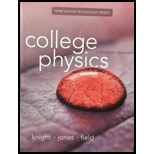
College Physics
3rd Edition
ISBN: 9780134143323
Author: Knight, Randall Dewey, Jones, Brian, Field, Stuart
Publisher: Pearson,
expand_more
expand_more
format_list_bulleted
Concept explainers
Question
Chapter 5, Problem 66P
To determine
The force applied by each officer on the plane.
Expert Solution & Answer
Want to see the full answer?
Check out a sample textbook solution
Chapter 5 Solutions
College Physics
Ch. 5.1 - Prob. 5.1STCh. 5.2 - Prob. 5.2STCh. 5.3 - Prob. 5.3STCh. 5.4 - Prob. 5.4STCh. 5.5 - Rank in order, from largest to smallest, the size...Ch. 5.6 - The terminal speed of a Styrofoam ball is 15 m/s....Ch. 5.7 - Prob. 5.7STCh. 5.8 - All three 50 kg blocks are at rest. Is the tension...Ch. 5 - Prob. 1CQCh. 5 - Are the objects described here in static...
Ch. 5 - What forces are acting on you right now? What net...Ch. 5 - Prob. 4CQCh. 5 - Prob. 5CQCh. 5 - Prob. 6CQCh. 5 - Prob. 7CQCh. 5 - Prob. 8CQCh. 5 - Prob. 9CQCh. 5 - Prob. 10CQCh. 5 - Prob. 11CQCh. 5 - Prob. 12CQCh. 5 - Prob. 13CQCh. 5 - Prob. 14CQCh. 5 - Prob. 15CQCh. 5 - Prob. 16CQCh. 5 - Prob. 17CQCh. 5 - Prob. 18CQCh. 5 - Prob. 19CQCh. 5 - Prob. 20CQCh. 5 - Prob. 21CQCh. 5 - Prob. 22MCQCh. 5 - Prob. 23MCQCh. 5 - Prob. 24MCQCh. 5 - Prob. 25MCQCh. 5 - Prob. 26MCQCh. 5 - Prob. 27MCQCh. 5 - Prob. 28MCQCh. 5 - Prob. 29MCQCh. 5 - Prob. 30MCQCh. 5 - Prob. 31MCQCh. 5 - Prob. 32MCQCh. 5 - Prob. 1PCh. 5 - Prob. 2PCh. 5 - Prob. 3PCh. 5 - Prob. 4PCh. 5 - Prob. 5PCh. 5 - Prob. 6PCh. 5 - Prob. 7PCh. 5 - Prob. 8PCh. 5 - Prob. 9PCh. 5 - Prob. 10PCh. 5 - Prob. 11PCh. 5 - Prob. 12PCh. 5 - Prob. 13PCh. 5 - Prob. 14PCh. 5 - Prob. 15PCh. 5 - Prob. 16PCh. 5 - Prob. 17PCh. 5 - Prob. 18PCh. 5 - Prob. 19PCh. 5 - Prob. 20PCh. 5 - Prob. 21PCh. 5 - Prob. 22PCh. 5 - Prob. 23PCh. 5 - Prob. 24PCh. 5 - Prob. 25PCh. 5 - Prob. 26PCh. 5 - Prob. 27PCh. 5 - Prob. 28PCh. 5 - Prob. 29PCh. 5 - Prob. 30PCh. 5 - Prob. 31PCh. 5 - Prob. 32PCh. 5 - Prob. 33PCh. 5 - Prob. 34PCh. 5 - Prob. 35PCh. 5 - Running on a treadmill is slightly easier than...Ch. 5 - Prob. 37PCh. 5 - Prob. 38PCh. 5 - Prob. 39PCh. 5 - Prob. 40PCh. 5 - Prob. 41PCh. 5 - Prob. 42PCh. 5 - Prob. 43PCh. 5 - Prob. 44PCh. 5 - Prob. 45PCh. 5 - Prob. 46PCh. 5 - Prob. 47PCh. 5 - Prob. 48PCh. 5 - Prob. 49PCh. 5 - Prob. 50PCh. 5 - Prob. 51PCh. 5 - Prob. 52PCh. 5 - Prob. 53PCh. 5 - Prob. 54PCh. 5 - Prob. 55PCh. 5 - Prob. 56PCh. 5 - Prob. 57PCh. 5 - Prob. 58PCh. 5 - Prob. 59PCh. 5 - Prob. 60PCh. 5 - Prob. 61PCh. 5 - Prob. 62PCh. 5 - Prob. 63PCh. 5 - Researchers often use force plates to measure the...Ch. 5 - Prob. 65PCh. 5 - Prob. 66PCh. 5 - Prob. 67PCh. 5 - Prob. 68PCh. 5 - Prob. 69PCh. 5 - Prob. 70PCh. 5 - Prob. 71PCh. 5 - Prob. 72PCh. 5 - A 2.7 g Ping-Pong ball has a diameter of 4.0...Ch. 5 - Prob. 74PCh. 5 - Prob. 75PCh. 5 - Prob. 76PCh. 5 - Prob. 77SPPCh. 5 - Prob. 78SPPCh. 5 - Prob. 79SPPCh. 5 - Prob. 80SPP
Knowledge Booster
Learn more about
Need a deep-dive on the concept behind this application? Look no further. Learn more about this topic, physics and related others by exploring similar questions and additional content below.Newton's Second Law of Motion: F = ma; Author: Professor Dave explains;https://www.youtube.com/watch?v=xzA6IBWUEDE;License: Standard YouTube License, CC-BY